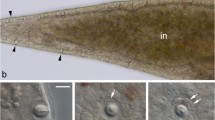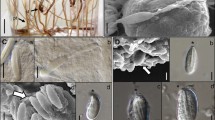Abstract.
The gastropods Cratena peregrina and Flabellina affinis (Nudibranchia, Aeolidacea) feed on Eudendrium racemosum (Hydrozoa). The question is addressed how the snails are protected against discharging nematocysts. When nematocysts of the hydrozoan discharged against the skin of the gastropods, the impact caused the epidermis to fold, and packets of epidermal vesicles were sloughed off. As vesicles opened, characteristic filamentous spindle-like structures were released. The discharging small microbasic eurytele nematocysts of the hydroid tentacles were blocked at the surface of the skin by mucus and/or by a layer of microvilli. Many secreted spindles from the epidermis of the snails were found among the everted nematocyst components. Discharging holotrichous isorhiza nematocysts of the hydroid cnidophores, however, caused complete lysis of epidermal cells of the gastropods, presumably due to the action of the hydrozoan toxins, which resulted in release of masses of spindles. Spindles then coated the nematocyst threads. It is proposed that the spindles in the epidermal cells of the snails serve a protective role, which ensures detachment of the hydroid tentacles and subsequent regeneration of the injured region of epidermis.
Similar content being viewed by others
Author information
Authors and Affiliations
Additional information
Electronic Publication
Rights and permissions
About this article
Cite this article
Martin, R., Walther, P. Protective mechanisms against the action of nematocysts in the epidermis of Cratena peregrina and Flabellina affinis (Gastropoda, Nudibranchia). Zoomorphology 122, 25–32 (2003). https://doi.org/10.1007/s00435-002-0064-x
Received:
Accepted:
Issue Date:
DOI: https://doi.org/10.1007/s00435-002-0064-x




